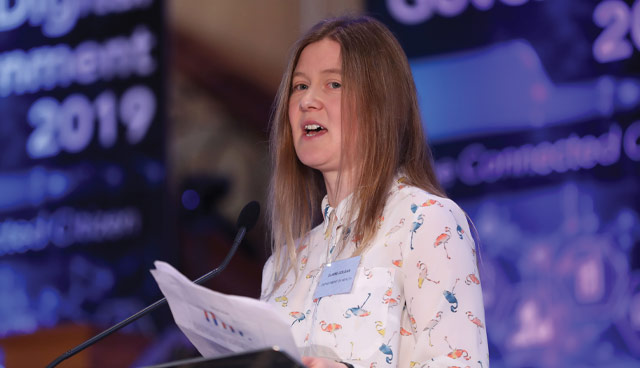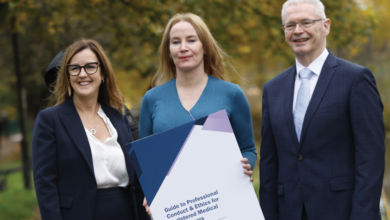Digitising and standardising healthcare

Head of eHealth and EU Engagement at the Department of Health, Elaine Colgan, talks to eolas about the digitisation of Northern Ireland’s health service records, the standardisation of health care and how both are “enabling care and empowering patients”.
“At the start of our journey, around 2010 and 2011, we had so many systems working in their own silos, that contained their own information and didn’t share that information with one another, which meant that clinicians couldn’t share that information efficiently between them,” Colgan explains. “Everybody has had experiences, either directly or indirectly, where people have told you they had to repeat everything they had told the last person they had seen. The solution for Northern Ireland for this was what we call NIECR – the electronic care record.”
The NIECR was created through a portal approach, placing it atop the Northern Ireland health system’s existing and disparate data and sucking it out and placing the data in one place for the first. “The feedback has been phenomenal,” Colgan says.
The NIECR now has 25,000 current active users, 30 per cent of which are nurses. “Right across the community, social care, health care, primary care, all the clinicians are using this now,” Colgan says. She outlines the key successes of the process as follows:
• Key information summary: “If you have a long-term condition, this allows your information to be shared across all the people who are tasked with your care. Normally that type of info would be held in your GP system, but now if you have to go to hospital for whatever reason they well be able to access your records”;
• The Diabetes pathway: “This has enabled standardisation of care for all Diabetes patients in Northern Ireland. Standardised care is the first step because you can’t digitise if everyone is doing things their own way. Standardisation is one of the trickier parts of the digitisation of healthcare and the Diabetes pathway has been a great success story in that regard”;
• Radiology: “Radiology orders are able to placed in one place now, bringing together the three regional systems. So that reduces the need for repeated tests and clinicians can see your previous test results”;
• Results sign-off: “A blood test or laboratory test of some kind needs to be signed off when the results are in, usually by the doctor that ordered it. This will now flag if results haven’t been signed off and because the results can be signed off digitally, this now makes the process a lot quicker”;
• Immediate discharge summary: “This has huge benefit for patients. If you’re in secondary care or hospital or have been an outpatient, instead of having to take a handwritten letter to your GP, this enables a standardised letter to be sent to your GP at the instant you leave. So as soon as you get to your GP, they will know what medications you’ve been given, what treatment you’ve undergone and any follow-up treatment that they are required to give you”; and
• Cross-border radiology: “This is mainly for patients in the border areas in the west or in Donegal who might get treatment at the cancer centre in Altnagelvin. Radiotherapy referrals can now be done cross-border and our counterparts in the south can make a referral for the north.”
It is, Colgan says, once you get passed the behind the scenes technical work that you begin to see the patient-facing benefits of digitisation and standardisation of care, including eTriage, and My Care Record, the patient portal version of the NIECR.
eTriage takes place when a patient attends their GP, who decides that they are unable to treat the patient and refers them to secondary care. What had previously been a paper-based system that created multiple opportunities for letters to get lost along the way is now done electronically, enabling the secondary care technician to see why the patient has been referred and allowing them to assign an appointment in minutes. “The best time that we’ve managed is somewhere around half an hour from the patient leaving the GP to having an appointment,” Colgan says. “That’s not the case for everyone but this has certainly reduced the timescale from a referral to getting an appointment.” The system was named an Award-Winning Solution at the 2018 UK Public Sector Paperless Awards.
The first phase of the rollout of My Care Record has been specifically targeted at dementia patients. “We’re taking the agile approach,” Colgan explains. “Phase one began August 2018 and what that includes is high-level information: your appointments, educational material about your condition, shared files that can be shared with those providing your care and a circle of care where you can nominate a family member or friend, which is particularly relevant for dementia patients, to be able to view your portal on your behalf and check your appointments and where you need to be.

“There’s a queue of conditions and clinicians who want to be able to interact with their patients. It’s about capturing and evaluating the benefits so that two or three years down the line we have the evidence that this is working.”
“Phase two will start soon and introduce goal setting. You can set your own goals, dietary or fitness goals, or a clinician can set a particular goal in the case of your treatment or care. Hopefully in the summer, phase three will introduce medication – so you can check online what medication you should be taking and how much if you’ve forgotten or lost the box – and your laboratory results.”
While managing the present transitions, the Head of eHealth is also looking to the future: “We’ve got Citizen Identification. At the moment we’re in the pilot phase, where the clinician knows the patient sitting in front of them and they onboard them, but when we think about scaling this up for all Northern Ireland patients, we have to ask how we identify patients and how do we enable them to identify themselves to access their records?
“We need to think about consent, particularly for children, and ask at what point do we stop automatic parental access to their records? We’ve started with dementia patients, but we need to think about where we go next. We’re thinking possibly Diabetes, but there’s a queue of conditions and clinicians who want to be able to interact with their patients. It’s about capturing and evaluating the benefits so that two or three years down the line we have the evidence that this is working.”
This future vision involves a completely role-based system, where a specific clinician, such as a physiotherapist, will have certain access approvals. “This is going to be a regional system, in order to do that all care will now be standardised using the one system rather than variations of the one system,” Colgan says.
“The question is what happens to all that work in the other patient portal: the answer is that there’s a definite need to press ahead with that work because it will take at least five years to have full rollout of this programme and we want to be able to have patients move seamlessly from one programme to the other,” she concludes.





